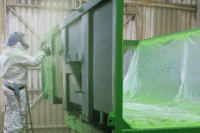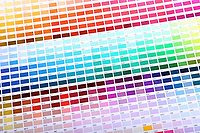Or read in our August Digital Edition.
Infrared (IR) spectroscopy is used extensively to characterize the chemical composition of trace evidence such as paints, fibers and adhesives as well as seized drugs and related chemicals. We have recently introduced the Thermo Scientific™ iS™50 ATR module, a novel, extended-range attenuated total reflectance (ATR) module that is integrated into the Nicolet™ iS50 FT-IR spectrometer. This ensures that the ATR module is always available for rapid analysis of unknown materials even with another accessory mounted in the sample compartment. The built-in ATR combines an optimized optical design with a diamond ATR crystal and a broad-range DTGS detector to provide high-sensitivity infrared spectroscopy from 4000 cm-1 to 100 cm-1. The enhanced stability, resulting from mounting the ATR within the sealed section of the spectrometer, makes it possible to acquire spectra down to 200 cm-1, even with a desiccated system.
Infrared spectroscopy is one of the few analytical techniques considered by the forensic science community to have the highest discriminating power required to provide confirmatory evidence about the chemical composition of a material. FT-IR is used extensively in most forensics laboratories to identify materials such as seized drugs and possible evidence from a crime scene.
One area where FT-IR has proven particularly valuable is analyzing automotive paint chips. A number of forensics laboratories have reported the significance of the infrared spectral range below 400 cm-1 in helping to identify specific inorganic pigments or minerals in a paint sample. Traditionally these measurements have been performed with a diamond compression cell or diffuse reflectance accessory on an FT-IR system that uses Cesium Iodide (CsI) optics to acquire spectra down to 225 cm-1. Suzuki et.al. have published a paper in the Journal of Forensic Science describing the application of extended-range FT-IR to the analysis of pigments in automotive paint. Dr. Suzuki has also created a library of more than 50 infrared reference spectra. The library; An Infrared Spectral Library of Automotive Paint Pigments (4000-250 cm-1) was developed at the Washington State Crime Laboratory and can presently be downloaded from the SWGMAT.org website.
Another excellent resource for analyzing automotive paints and pigments is the International Forensics Automotive Paint Data Query (PDQ) database developed by the Royal Canadian Mounted Police Forensics Laboratory Services. Much of the infrared spectral data in this database contains peak information down to 225 cm-1. While the advantages of extended-range FT-IR may be clear, obtaining high-quality transmission spectra requires a great deal of experience and careful sample preparation. The CsI optics typically used to scan this range are delicate and hydroscopic, so great care must be taken to maintain a low-humidity environment within the instrument and handle the beam splitter with extreme caution. Also, preparing a paint sample that is sufficiently thin and fringe-free to work in a diamond anvil cell form can be challenging to an inexperienced examiner. The diamond windows not only compress the sample but are transparent in both the mid- and far-IR spectral region.
In this article we will discuss a novel feature of the Nicolet iS50 FT-IR spectrometer that provides a rapid, easy way to acquire spectra down to 100 cm-1. The system that we used was configured with the built-in iS50 ATR module and an iS50 ABX Automated Beamsplitter exchanger. With this configuration, both a mid-IR and far-IR spectrum can be acquired from a sample with a single operation. In this report, extended-range far-IR spectra were acquired from 1800 cm-1 to 100 cm-1, with the solid substrate beamsplitter and the integral diamond ATR shown in Figure 1. High-quality spectra were acquired at 4 cm-1 resolution in a couple of minutes.
Infrared Spectroscopic Analysis of Inorganic Pigments: ATR Spectra from 1800 to 100 cm-1
As mentioned, one of the important advantages of extended-range FT-IR is the ability to detect the peaks from inorganic pigments and fillers found in many coatings and plastics. In this example, we downloaded the spectra that Dr. Suzuki made available on the SWGMAT.org website and created a custom spectral library that could be used with the Thermo Scientific OMNIC™ search software. The first sample analyzed was a small piece of white plastic. The best match found with the spectral search was the spectrum of rutile, which is a TiO2 compound used as a whitener. Figure 2 shows a comparison of the ATR spectrum and the transmittance reference spectrum from the Washington State Crime Laboratory (WSCL) library. The two reference peaks described in Dr. Suzuki’s paper for rutile are clearly present in this sample. A second example is actually a bright yellow plastic material with two large peaks below 400 cm-1. While it may be possible to identify the calcite with the peaks above 400 cm-1, as in Figure 3, the only peak in the reference spectrum of cadmium yellow is near 250 cm-1 and matches nicely with the strong feature in our extended-range ATR spectrum.
Analyzing Automotive Paint with Extended-Range FT-IR: ATR Spectra from 1800–100 cm-1
One unique feature of ATR spectroscopy is the limited depth of penetration into the sample. The depth of penetration is dependent on the wavelength of the infrared light and the refractive index of the sample.
While the depth of penetration in the far-IR region may be several microns, this may still be smaller than the thickness of the paint layers. Figure 4 shows the spectra acquired from both sides of a paint sample. The spectra from the two sides are clearly different, indicating that we have at least two paint layers present in the sample.
Spectral subtraction can often be employed to sort out the different spectral features and avoid having to manually separate the paint layers. Because all of the components in the built-in ATR module were optimized specifically for the Nicolet iS50 spectrometer, the sensitivity is excellent. Although the Nicolet iS50 instrument is not designed as a micro-spectrometer, excellent infrared spectra can be rapidly obtained from samples smaller than 1 mm. This sensitivity is shown in the ATR spectra from a small sliver of paint in Figure 5.
Comparing ATR and Transmission Spectra
A spectrum acquired with the extended-range, built-in ATR from a second paint chip is compared to the corresponding transmission spectrum. Although the sample preparation methods were different as well as the measurement techniques, the spectra are quite similar after applying the OMNIC software advanced ATRcorrection function. In addition, the ATR spectrum shows a few significant features below the 220 cm-1 cutoff of the transmittance spectrum acquired with CsI optics.
Conclusion
In this article we have shown a number of spectra acquired with the Nicolet iS50 spectrometer and the new extended-range, built-in ATR module. The integrated ATR module makes it easy to rapidly obtain infrared spectra all the way down to 100 cm-1 from small amounts of sample. This demonstrates that a high-sensitivity extended-range, built-in ATR can play a significant role in the forensics laboratory. We believe that with proper validation the extended-range ATR can provide a complementary method to characterize materials of interest to the forensic scientist. Building the Nicolet iS50 spectrometer with the integrated iS50 ATR module offers the user an instrument with two sampling stations. The sample compartment remains available for transmission analysis or for inserting other accessories and modules. Combining the built-in ATR with the Nicolet iS50 Raman module with an infrared microscope creates a strong foundation for molecular spectroscopy in the forensics laboratory.
Acknowledgement
We would like to acknowledge Dr. Mark Sandercock, Manager of Trace Evidence Operations Support, National Centre for Forensic Services, Royal Canadian Mounted Police for helpful discussions and providing the paint samples with corresponding spectra.
References
1. Cassista, A. R.; Sandercock, P. M. L. Comparison and identification of automotive topcoats: Microchemical spot tests, microspectrophotometry, pyrolysis gas chromatography, and diamond anvil cell FTIR, Canadian Society of Forensic Sciences Journal (1994) 27:209–223.
2. Lavine, B.K.; Mirjankar, N.; Ryland, S.; Sandercock, P.M.L. Wavelengths and genetic algorithms applied to search prefilters for spectral library matching in forensics, Talanta (2011) Dec 15; 87:46–52.
3. Scientific Working Group on Materials Analysis (SWGMAT). Standard Guide for Using Infrared Spectroscopy in Forensic Paint Examinations (2009).
4. Suzuki, E.M.; McDermot, M. X. Infrared Spectra of U.S. Automobile Original Finishes. VII. Extended Range FT-IR and XRF Analyses of Inorganic Pigments In Situ Nickel Titanate and Chrome Titanate; J. Forensic Sci., (2006) 532–547.
5. Ryland, S.; Bishea, G.; Brun-Conti, L.; Eyring, M.; Flanagan, B.; Jergovich, T.; MacDougall, D.; Suzuki, E. J. Forensic. Sci., (2001) 46, 31–45.
6. Royal Canadian Mounted Police Forensics Laboratory Services: International Forensics Automotive Paint Data Query (PDQ) database http://www.rcmp-grc.gc.ca/fs-fd/pdfs/pdq-eng.pdf.
7. Koulis, C.V.; Reffner, J.A.; Bibby, A.M. Comparison of Transmission and Internal Reflection Infrared Spectra of Cocaine, J. Forensic Sci., (2001) 46 (4):822–629.
8. Lv, J.; Feng, J.; Liu, Y.; Wang, Z.; Zhao, M.; Cai, Y.; Shi, R. Discriminating Paints with Different Clay Additives in Forensic Analysis of Automotive Coatings by FT-IR and Raman Spectroscopy, Spectroscopy, (2012) 27(4), 36–43.











Report Abusive Comment